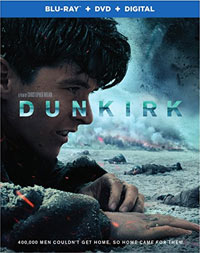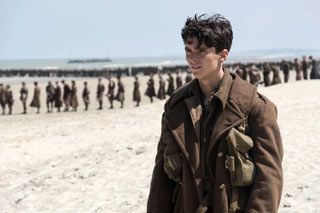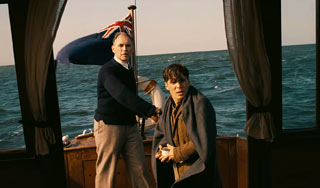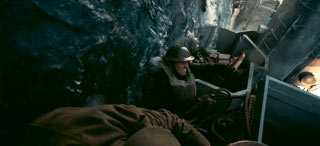

 - for intense war experience and some language.
- for intense war experience and some language.
Allied soldiers from Belgium, the British Empire and France are surrounded by the German army and evacuated during a fierce battle in World War II. (from IMDB.com)

Indie director extraordinaire Christopher Nolan made the transition from gritty psychological thrillers (the R-rated Memento and Insomnia) to the big-budget blockbusters with 2005's Batman Begins -- and hasn't looked back since. With the success of Batman Begins, Nolan has gone on to direct two more Batman films, rounding out the "Dark Knight Trilogy" and has also released several pet projects of his own in between those DC Comics chapters, like The Prestige and Inception. Each of Nolan's efforts have been deep, often thought-provoking projects, bringing added depth to the kind of popcorn-munching summer fare people have grown accustomed to. It's this kind of skillful and thoughtful film making that makes the major success of his latest entry, a war film, not too surprising.
Dunkirk seems like a significant departure from the norm for Nolan, not only serving as a war film, but something based on a true event in history -- a true first for Nolan. The stories told here are fictitious, but they're set within the real event that occurred during World War II, and the narrative is designed to be thrilling, tense and unsettling. But Nolan's unconventional means of storytelling here isn't quite enough to make the story suspenseful; it's the score from longtime musical collaborator Hans Zimmer that takes it to the next level, delivering a hair-raising soundtrack that is likely to have your pulse racing while you squirm in your seat. Nolan's unconventional storytelling narrative also lends a little intentional confusion to the film that helps ratchet up the tension. When you start to realize that the storylines aren't necessarily happening at the same exact time, it adds another level of excitement.

To complete the package, the acting in the film is solid. There's a mix of fresh and veteran talent, having some familiar faces interspersed among a sea of new ones. The new talent, in this case, Fionn Whitehead, make it easier to feel like you're following actual soldiers on the battlefield, and it pulls you into the story more. Even though you'll see recognizable faces like Kenneth Branagh and Cillian Murphry peppering the scenery as well, they just bring an added sense of clout to the material -- and they're excellent in their respective roles (as one would expect). The plot weaves in and out of the different stories - soldiers trying to escape Dunkirk, boats coming to help them out, and planes in the air trying to keep the skies clear. It doesn't leave much room for character development or even arcs, but it helps paint a well-rounded portrait of what this event must have been like for soldiers of all kinds, nationalities, and ranks.
When trying to describe the tone and feel of the film, it helps if you're familiar with Nolan's work. For example, most of his films hit a point where all of the tension is building and coming to a head, ready to explode in some fashion -- and usually, it involves several story lines at once. In Inception, it's when the van is going over the side of the bridge in slow motion and the clock is ticking on the deep dreamers; in Interstellar, it's when Coop is experiencing a life-threatening scuffle on a planet while his daughter and son on Earth are in the midst of a domestic dispute; in The Dark Knight, it's around the time Batman realizes who The Joker is targeting. They're all moments where the story is jumping between characters during nail-biting situations. If you made nearly an entire film of that kind of tension and those kinds of moments, you'd have Dunkirk. Some of the tension is simply because you can tell that Nolan is laying the puzzle pieces out on the table, and it's all leading up to something, all the while you have Zimmer's score ticktocking through each scene. And it works!

The content is shockingly mild for a war film. Language is infrequent, but one scene has 3 uses of the "F" word (1 isn't immediately noticeable). There is plenty of war violence, but it's never graphic and only seldom bloody. In fact, you can count two instances of blood in the film - one on bandages on a soldier being carried on a stretcher, and another scene when a person falls and injures their head. In the latter scene, someone goes to help the person who fell and finds blood on their fingers when touching the victim's head. Finally, there's no sexual content of any kind.
Dunkirk isn't your typical blockbuster film, and most young people will probably go just to see singer Harry Styles' acting debut, but it's a solid film with a great story, a unique narrative, and an intense score. If you don't typically like war films, you may want to pass on this one, otherwise Dunkirk is an excellent film about the human spirit - great and small - and the little victories and sacrifices during a time of great cost and loss.
- John DiBiase (reviewed: 8/2/17)
The famous story of the miracle of Dunkirk is available to own now through all formats, including 4K UHD. We received a Blu-Ray combo pack for review, which includes the blu-ray disc, DVD, and a digital copy. The HD transfer is beautiful, and there are plenty of extras, all packed onto a bonus Blu-Ray disc. They are all making-of featurettes that are spread across five separate sections.
Creation (22:15) Each section of featurettes are divided with their own chapters. "Revisiting the Miracle" leads things off, featuring Christopher Nolan talking about how he wanted to make this movie for a while and spent a lot of time researching the story and discussing it with veterans who survived the experience. "Dunkerque" is about how the film crew shot the beach scenes on the real Dunkirk beach! "Expanding the Frame" reveals that 70% of the movie was shot in IMAX format using IMAX cameras! "The In-Camera Approach" discusses the use of physical effects in the film and "doing it for real" on camera without relying on digital effects. Nolan used very little CGI for this movie, and the actors talk about the experience for them. (It sounds like Harry Styles uses 1 "S" word in one interview.)
Land (16:36)
"Rebuilding the Mole" is about how the crew rebuilt the infamous pier that stuck out from the Dunkirk beach, using the original structure as a base. They experienced all kinds of challenges while attempting to build it, however, including the tide washing parts away at night after they built part of it earlier in the day. "The Army on the Beach" is about the use of practical effects, including the use of printed standees of extras to fill out the army numbers. "Uniform Approach" then covers the film's costumes and how they tried to strike a balance between historically accurate and appealing. They also showed the technique they used to wear them down to look like they've been through battle.
Air (18:27)
"Taking to the Air" is all about the airplanes used in the film, and how they turned a "yak" plane into a "spitfire." Nolan and the crew talk about trying to do everything real and in camera for the plane scenes, going so far as to attach an IMAX camera to an airplane wing! They invented new techniques for doing things, like shooting inside the cockpit while using a gimbal to do the scenes with a practical background and no green screen!
Sea (36:52)
In "Assembling the Naval Fleet," we learn about how they brought the scenes at sea to life. The production had to find similar ships to the ones used, even some that were only half the size of the real thing! But with Hollywood magic, they were able to make it work. "Launching the Moonstone" focuses on the "hero" ship of the film, and how they worked hard to find the right ship and customize it for use in the film. "Taking to the Sea" is about moving the production to Iceland for some of the ship-sinking scenes. It also talks about shooting IMAX on a little boat and the dangers of such a task. We also learn that the scenes where actors were covered in oil actually featuted a vegetable-based mixture to pose as the oil -- and they used gas under the water's surface to ignite fires on top of the water. We also learn that, in an attempt to shoot in IMAX on a plane's wing, the plane and the camera sank to the bottom of the ocean! "Sinking the Ships" is about how they shot some scenes of the sinking ships on location, while other scenes--especially the ones using actors--were shot in a tank in L.A. with sets. Lastly, for "The Little Ships," we learn about The Association of Dunkirk Little Ships, an organization that helped supply some of the actual, real ships from the real-life event to be used in this film!
Conclusion (15:16)
Turning Up the Tension is dedicated to the music in the film, and how that sound and tension were both born from the sound of a ticking watch. We also learn how the music was often amping up along with what was happening in the movie, and how the music and movie were edited around the same time to be in sync. Things like the boat motors are even in sync with the music! And finally, "The Dunkirk Spirit" features the cast and crew talking about "the Dunkirk spirit" and what it means to them.
- John DiBiase, (reviewed: 12/18/17)
Disclaimer: All reviews are based solely on the opinions of the reviewer. Most reviews are rated on how the reviewer enjoyed the film overall, not exclusively on content. However, if the content really affects the reviewer's opinion and experience of the film, it will definitely affect the reviewer's overall rating.
 "HOPE" is Coming, Petra's First New Studio Album in 20 Years "HOPE" is Coming, Petra's First New Studio Album in 20 YearsWed, 24 Dec 2025 13:30:00 EST |
 John Schlitt Releases Limited Vinyl Edition of "The Christmas Project" John Schlitt Releases Limited Vinyl Edition of "The Christmas Project"Tue, 23 Dec 2025 18:00:00 EST |
 Elan Brio Shares His Passion, 'Written In Sound,' Alongside Nikkuubeats Elan Brio Shares His Passion, 'Written In Sound,' Alongside NikkuubeatsMon, 22 Dec 2025 14:20:00 EST |
 m1L and R.kitect Announce New EP and Lead Single m1L and R.kitect Announce New EP and Lead SingleMon, 22 Dec 2025 14:05:00 EST |
 "David," Starring Phil Wickham, Earns Highest-Grossing Faith-Based Animated Theatrical Opening of All Time "David," Starring Phil Wickham, Earns Highest-Grossing Faith-Based Animated Theatrical Opening of All TimeSun, 21 Dec 2025 16:05:00 EST |
 Phil Wickham Breaks Mediabase Record with No. 1 Song Phil Wickham Breaks Mediabase Record with No. 1 SongFri, 19 Dec 2025 18:10:00 EST |
 B. Cooper Releases New Single, "Back," ft. 350 B. Cooper Releases New Single, "Back," ft. 350Fri, 19 Dec 2025 17:25:00 EST |
 Click here All News Headlines |
Click here All News Headlines |